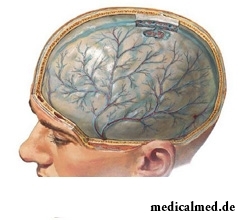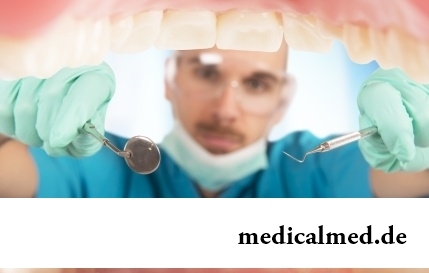





Brain bruise

The bruise of a brain belongs to heavy traumatic damages with characteristic focal disorders of brain activity. An obligatory symptom of a bruise of a brain is the loss of consciousness. Depending on weight of an injury, the injured person can be unconscious quickly (several minutes) or is rather long (several days and even weeks).
The area of localization of an injury at a bruise of a brain can be located not only in the direct place of a bruise, but also from the party opposite to it, in that case when the brain receives counter-weight blow about a bone of own cranium.
Effects of a bruise of a brain are very heavy and are not always predictable. As one of many adverse forecasts, is possible the following option - emergence of serious disorders of circulator character, increase in pressure of cerebrospinal fluid, development of prompt hypostasis of a brain.
Cases when bruises of a brain are accompanied by subarachnoidal bleedings are frequent. This critical situation is dangerous that blood decomposition products (in particular – bilirubin) in the absence of immediate medicamentous therapy almost inevitably start in action aseptic inflammatory processes in a meninx. The similar condition of the patient is described by the medical term how subfebrile condition or a meningeal syndrome.
Weight of a condition of the patient with a bruise of a brain and possible effects for his health most precisely are defined by specialists in the conditions of a medical hospital after carrying out the corresponding inspections and analyses. Objectivity of assessment of a condition of the victim, forecasts for his successful recovery to a large extent depend on a type of a bruise of a brain and the overall clinical picture.
Types of bruises of a brain
Specialists classify brain bruises according to the following severity:
- Easy degree. It is diagnosed for about 15 percent of all victims of a craniocereberal injury. After a bruise of a brain of easy severity the victim faints for short time (of several minutes till several o'clock). Symptoms of retrograde, anterograde and kongradny amnesia are observed. Developing of repeated or single vomiting is possible. In some cases the cordial and respiratory rhythm is moderately broken, arterial pressure increases.
In most cases poorly expressed symptoms of neurologic character pass through few weeks and health of the patient is completely recovered.
Brain bruises at the child of easy severity are rather widespread cases in pediatric practice since owing to the age juvenile children often fall, hitting-headed.
- Average degree. It is diagnosed for about 10 percent of all victims of craniocereberal injuries. After a bruise of a brain of moderate severity the victim can stay in unconsciousness till seven o'clock. Insignificant disturbances of some vital functions are observed. Body temperature, disturbance of visual functions and so forth increases. Often the bruise of a brain of average degree is combined with subarachnoidal hemorrhage, a change of the arch and base of skull.
- Heavy degree. It is diagnosed for about 7 percent of all victims of craniocereberal injuries. Long stay in a coma is characteristic of the victim of a bruise of a brain of heavy degree. Coma is accompanied by asymmetric or symmetric decerebration (shutdown of functions of a brain). Essential disturbances of frequency and a respiratory rhythm, cordial activity, a hyperhidrosis (strong sweating), increase in pressure, body temperature and other symptoms are observed.
Brain bruise symptoms
There are following symptoms of a bruise of a brain depending on the severity which was traumatized:
- loss of consciousness;
- retrograde amnesia;
- headache and dizziness;
- lack of coordination;
- nausea, vomiting;
- the changed consciousness;
- disturbance of visual functions (a temporary blindness, a photophobia, doubling in eyes);
- expansion of pupils;
- dysfunction of the speech;
- disturbance of acoustical functions;
- disturbance of a deglutitory reflex;
- decrease in pulse;
- weak and bradypnoea;
- blood supertension;
- anesthesia of some parts of a body;
- loss of control over functions of urination and defecation;
- bloody (or without blood impurity) allocations from nasal and ear passes;
- paralysis;
- coma.
Diagnosis of a bruise of a brain

As well as at any other craniocereberal injury for an exception of the prolonged negative effects of a bruise of a brain immediate performing careful medical examination with use of all necessary diagnostic means is shown to the victim.
Before a direct initiation of treatment of a bruise of a brain, the medical personnel estimate a condition of cardiovascular and respiratory system of the victim. Then the general survey of a body of the patient regarding detection of the traumatic damages, combined with a bruise of a brain, is carried out.
The neurologic inspection including definition of reaction of pupils of the victim to a light irritant, diagnosis on a scale of a coma of Glasgow etc. becomes the following obligatory evaluation stage of the general state and probable symptoms of a bruise of a brain.
The most irreplaceable diagnostic means at suspicion of a craniocereberal injury is the computer tomography for today. This type of inspection allows to define most authentically existence of the smallest hemorrhages and hematomas in a brain and possible fractures of bones of a skull. Magnetic and resonant inspection is also rather effective at diagnosis of bruises of a brain, but is put into practice much less often since preparation for this procedure requires considerable time.
Treatment of a bruise of a brain
The existing methods of treatment of bruises of a brain are subdivided on therapeutic and surgical.
Therapeutic methods of treatment of bruises of a brain consist in medicamentous elimination of the raised intracranial hypertensia. Besides, the preventive measures preventing possible developing of hypostasis of a brain are obligatory.
Urgency of neurosurgical treatment of bruises of a brain is dictated by need of urgent elimination of the physical factors causing squeezing of brain fabric. Hemorrhages, hematomas and bone fragments in a craniocereberal cavity which cannot be eliminated by means of medicines are removed during surgery – osteoplastic trepanation.
Caries is the most widespread infectious disease in the world to which even flu cannot compete.

During foot walks blood moves on vessels more actively and one and all bodies are supplied with a large amount of oxygen. N...
Section: Slideshow
Color of plants is caused by presence at them of certain chemical compounds. Let's talk about what is meant by various colors of vegetables and fruit and what properties they give them....
Section: Articles about health
Cystitis, or inflammation of a mucous membrane of a bladder, this very widespread disease which, owing to some features of a structure of bodies of urinogenital system, women have approximately four times more often than men. Women aged from 20 up to 45 years enter into the main risk group. Cystitis is an illness of a bacterial origin. It can have an acute or chronic current. The second option is dangerous not only a frequent recurrence, серьезн...
Section: Articles about health
"Epilepsy" doctors made the diagnosis in antique times. Displays of an illness and pattern of its development are very well studied. Odes...
Section: Articles about health
Very often as a source of the infection which caused a disease serves our house - the place which a priori has to be safe. However disease-producing bacteria can perfectly feel not only in insanitary conditions, but also in our apartment if not осущ...
Section: Articles about health
Work of a brain is extremely complex and in many respects is not studied yet. It is confirmed also by the features of thought processes which are shown when the person sleeps. Let's tell about some of them....
Section: Articles about health
Good appetite was always considered as a sign of good health. The correct operation of the mechanism which is responsible for the need for nutritious...
Section: Articles about health
The main role in development of a peptic ulcer of a stomach and duodenum the bacterium Helikobakter plays pilor. Activity and the strengthened reproduction of this microorganism lead to weakening of protection of mucous membranes and their erosive damage. Manifestations not...
Section: Articles about health
It is possible to find the extensive range of fruit and vegetables in modern shops. Russians already got used that on counters there is not only a seasonal domestic production, but the vegetables and fruit which are grown up in the countries with more comfortable conditions of cultivation at all seasons of the year. However what we see in shops and in the vegetable markets, is only a small part of those edible plants with which the nature is so rich. Today we want to acquaint the reader with rare and very useful vegetables which on...
Section: Articles about health
Statistically, pathologies of a thyroid gland in the world more than 500 million people have. Failures in work of this body conduct to is heavy...
Section: Articles about health
Long time antibiotics were considered as a panacea from all diseases and were appointed even at insignificant symptoms of an infection. Even now not everyone knows in what force of antibiotics how and when they should be accepted. Let's discredit 7 popular myths about such drugs...
Section: Articles about health
For many women the word "fat" sounds as a sentence. In aspiration to an ideal figure they try to exclude, first of all, from the menu all dishes containing fats without having at the same time a clear idea of a role of these substances in exchange processes, and of effects for health with which food restrictions of this sort are fraught. For what the human body needs fats and as their deficit in a diet is shown, we also will try to find out....
Section: Articles about health
Each person supports all life a SARS about 200 times. The peak of incidence falls on cold season, but to get sick from temperatures...
Section: Articles about health
All are familiar with cold, and practically everyone believes that he has sufficient knowledge and experience that correctly to treat it. In practice most of people makes mistakes in attempts to get rid of rhinitis, and divides numerous delusions it....
Section: Articles about health
Traveling all over the world, many try to try the most exotic dishes of national cuisines. There is even a so-called gastronomic tourism which, according to gourmets, not only allows to receive new feelings, but also is capable to show life of other people from absolutely unexpected side....
Section: Articles about health
The body of the person almost for 60% consists of water. It is so important for normal functioning of an organism that loss of all is ponut...
Section: Articles about health
Memory is an ability of the central nervous system to fix, keep and as necessary to reproduce information on knowledge or skills received by the person or an animal during life. The mechanism of this process is up to the end not studied....
Section: Articles about health
The metabolism at each person proceeds in own way. However between the speed of this process and disposal of excess weight after all all have a dependence. Unfortunately, the people inclined to try on itself numerous "miracle" diets, not always consider this circumstance and with the most resolute intentions begin to eat so that artificially slow down the metabolism instead of to accelerate it. Except quite clear disappointment, incorrectly picked up systems...
Section: Articles about health
According to data of World Health Organization, the cataract is diagnosed almost for 7% of the population of Earth. Statistics we get sick...
Section: Articles about health
White teeth and the Hollywood smile – a dream of many people. Long time was considered that the plaque on teeth and change of their color – destiny of those who incorrectly eat smokes and badly brushes teeth. But the paradox is available: at everything the variety of toothpastes existing today...
Section: Articles about health
We live during an advertizing era. Daily each person receives a solid portion of persuasive councils about what to eat to be healthy and successful. Products about which we will talk today are combined by the following circumstance: all of them are positioned as the most useful and the most suitable for inclusion in a morning meal. Unfortunately, it is not true: these 10 products do not suit for breakfasts at all....
Section: Articles about health
The drugs stopping or oppressing life activity of pathogenic microorganisms are widely applied in clinical practice with 4...
Section: Articles about health
Epilepsy is one of widespread neurologic diseases. Parents, whose children suffer from this illness, should face rumors and delusions, many of which remained since the Middle Ages....
Section: Articles about health
Run - one of the most available and effective ways to revitalize the organism. Knowing about its extraordinary advantage, each of us at least once tried to make jogs, but only the few made these occupations regular. In spite of the fact that in jogging (easy jogging), apparently, there is nothing difficult, the beginning runners often make mistakes which lead to complete cessation of trainings. Let's consider 10 useful tips for beginners who will allow them to make regular п...
Section: Articles about health
So, you resolved to lose weight. And now you try to understand what to begin with: from exercise stresses or a diet? And how to make, h...
Section: Slideshow
Sooner or later hair turn gray at all. Many people try to hide these changes, returning natural color of the hair by means of coloring, or considerably changing it for the purpose of creation of absolutely new image. All know that the gray hair is a sign приближающ...
Section: Articles about health
Practice of hypnotic impact on consciousness of the person contains about two millennia. During this time scientists managed to learn a lot of things about a phenomenon of hypnosis and learned to facilitate a condition of the patients having heavy illnesses with its help....
Section: Articles about health
